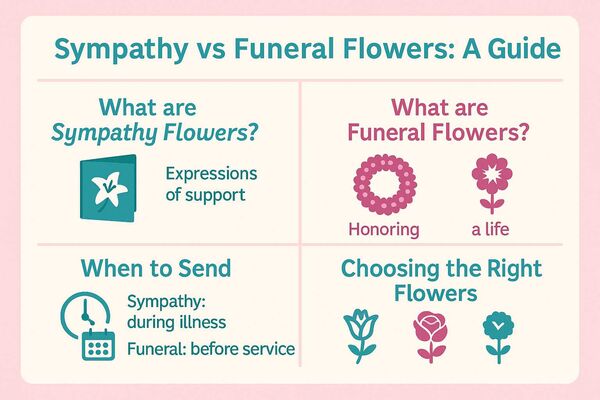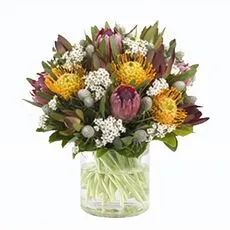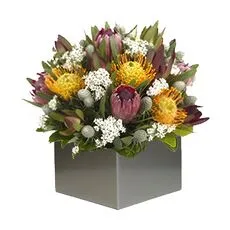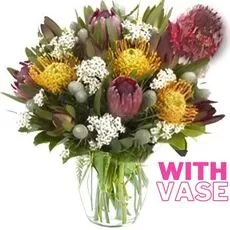Understanding Sympathy vs. Funeral Flowers

You've just heard the news about someone's passing, and you want to send flowers. You're standing there in front of your computer or at a brick and mortar florist near to where you live, and suddenly you're hit with options: "sympathy flowers" or "funeral flowers."
What's the difference? Does it even matter?
Yes, it absolutely matters. And after years in the flower business, I can't tell you how many well-meaning people have accidentally sent the wrong type to the wrong place at the wrong time.
Let me break this down for you in a way that'll stick.
The Quick Answer (For Those in a Rush)
Funeral Flowers
For the deceased
Honour and remember the deceased during the service
Sent directly to funeral home, church, or service venue
Formal wreaths, casket sprays, standing arrangements
Delivered before or during the funeral service
Traditional & ceremonial tribute
Sympathy Flowers
For the living
Comfort and support the grieving family
Sent to family's home or workplace
Bouquets, potted plants, smaller personal arrangements
Can be sent anytime during the grieving period
Personal & ongoing comfort
The choice between sympathy and funeral flowers represents a meaningful decision in expressing condolences, with each serving distinct purposes in the grieving process.
Funeral flowers = For the deceased, sent to the service venue Sympathy flowers = For the living, sent to their home
But there's so much more to it than that. Let's dive deeper.
Understanding the Difference
Funeral Flowers: The Public Tribute

Funeral flowers serve as formal tributes to honour the deceased during the actual service, featuring larger, more ceremonial arrangements like standing sprays and wreaths that are specifically designed for display at funeral homes, churches, or memorial services.
Think of funeral flowers as the floral equivalent of a eulogy – they're a public declaration of respect, love, and remembrance. Funeral flowers are primarily intended to pay tribute to and honour the memory of the person who has passed, serving as a mark of respect at the formal service, viewing, or wake.
These arrangements:
- Go directly to the funeral home, church, or service venue
- These arrangements contribute to the atmosphere of the memorial event, creating a respectful and often beautiful setting for remembrance.
- Add decoration to the ceremony and express respect for the person who has passed
- Usually feature larger, more formal designs
- Often include standing sprays, wreaths, or casket arrangements
Here's something crucial: It's not customary to send funeral wreaths or sprays to someone's home, as those are designed specifically for memorial services. I've seen families receive massive standing sprays at their doorstep – awkward doesn't begin to describe it.
Sympathy Flowers: The Personal Comfort

Sympathy flowers are designed to provide ongoing comfort and support to the bereaved family in their home environment, typically featuring smaller, more intimate arrangements that can be sent at any time following a loss.
These are your "I'm thinking of you" flowers, your "we're here for you" bouquet. Sympathy flowers are meant to provide comfort and support to the bereaved in the days and weeks following the death, serving as ongoing gestures of care that extend beyond the formal funeral proceedings.
What makes sympathy flowers special:
- The flexibility in timing allows senders to offer comfort when it may be most needed, particularly after the initial flurry of funeral activities has subsided and the reality of loss begins to settle in.
- They're meant to be kept and enjoyed by the family
- Unlike the formal tributes at a service, sympathy flowers tend to be life-affirming and aimed at lifting the spirits of those grieving.
- They come with personal messages of support
The Flower Types: What Works Where
Now, let's talk specifics. Different flowers carry different meanings, and some are more appropriate for funerals versus sympathy arrangements.
Funeral & Sympathy Flower Guide
Traditional choices and their meanings for Australian contexts
Classic Funeral Flowers
- White LiliesSymbolise restored innocence and purity of heaven. The heavyweight champion of funeral flowers.
- ChrysanthemumsTraditional association with death and mourning, particularly in Europe and Asia.
- GladioliEpitomise strength of character, integrity, and remembrance. Perfect for standing sprays.
- CarnationsPrized for longevity and gentle fragrance. Workhorses of the funeral flower world.
Sympathy Favorites
- RosesVersatile and meaningful. White for purity, red for love and grief, pink for admiration.
- OrchidsWhite or pink varieties convey enduring love and sympathy. Perfect for lasting arrangements.
- Mixed Garden BouquetsCheerful arrangements often sent in vases that can be kept as mementos.
Australian Native
- WaratahsNSW floral emblem, perfect for those with strong Australian connections.
- BanksiasUnique Australian blooms representing endurance and natural beauty.
- Eucalyptus & WattleEspecially meaningful for those with nature or Indigenous heritage connections.
Classic Funeral Flowers
White Lilies: The heavyweight champion of funeral flowers. Lilies (especially white lilies) are one of the most iconic funeral flowers. In Western traditions they symbolise the restored innocence of the departed soul and the purity of heaven. Their elegance makes them perfect for formal displays.
Chrysanthemums: Here's where it gets interesting. Chrysanthemums are traditionally associated with death and mourning, particularly in Europe and Asia. In Australia? In Australian contexts, lilies, roses, and native flowers like waratahs and banksias are commonly chosen for funerals, as these flowers convey respect and sympathy, making them suitable for expressing condolences.
Gladioli: Gladioli are tall, spear-shaped flowers commonly found in standing funeral sprays. They epitomise strength of character, integrity, and remembrance. Perfect for that impressive fan spray at the service.
Carnations: Carnations are prized for their longevity and gentle fragrance, making them popular in funeral and sympathy flowers. They're workhorses of the funeral flower world – beautiful, lasting, and meaningful.
Sympathy Flower Favorites
Roses: Versatile and meaningful. Roses convey love, respect, and reverence in both funerals and sympathy gestures. The meaning can vary by colour – white roses denote purity and reverence, red roses signify love and grief (often from a spouse or close family), and pink roses express admiration and gratitude.
Orchids: These beauties are perfect for sympathy arrangements. Orchids, particularly white or pink varieties, convey a message of enduring love and sympathy. In some traditions, a single white orchid plant is sent to grieving family members as a lasting expression of your condolences.
Mixed Garden Bouquets: Don't underestimate the power of a cheerful mixed bouquet for sympathy. Sympathy flowers can be a bouquet or an arrangement and are often sent in a vase or basket that can be kept as a memento.
Australian Native Touches
In Australia, it's not uncommon to incorporate Australian native flowers like waratahs, banksias, eucalyptus, or wattle in funeral or sympathy arrangements, especially if the deceased had a strong connection to nature or Indigenous heritage.
Size and Style: Getting It Right
Funeral Arrangements: Go Big or Go Formal
Funeral flowers are usually larger arrangements or standing sprays that are designed to create visual impact in formal settings. We're talking:
Standing Sprays: These arrangements include standing sprays, wreaths, casket sprays, and special tributes that serve ceremonial functions during the service. Usually one-sided, designed to face the congregation.
Wreaths: Wreaths are circular to represent the circle of life and eternity. Classic, traditional, always appropriate from friends or extended family.
Casket Sprays: The big one. Casket sprays are usually supposed to be put on top of the casket and are typically ordered by the family of the departed. This is usually reserved for immediate family – for instance, the spouse, children or siblings will traditionally organise the casket flowers.
Pro tip: If you are not a close family member, it's more appropriate to send a different arrangement rather than a casket spray. Trust me on this one.

Sympathy Arrangements: Think Home-Friendly
The physical characteristics of sympathy and funeral flowers reflect their different purposes and display environments. Sympathy flowers can be a bouquet or an arrangement and are often sent in a vase or basket that can be kept as a memento.
Perfect sympathy options:
- Vase arrangements (no fuss for the family)
- These arrangements prioritise accessibility and manageability, featuring designs that families can easily relocate within their homes and maintain with minimal effort.
- Small, elegant bouquets
- Potted plants (such as a peace lily or orchid plant) are also popular sympathy gifts, as they serve as a lasting keepsake in memory of the deceased.
Timing Is Everything
Here's where people really get confused, so pay attention:
Timing Is Everything
When to send funeral vs sympathy flowers
Funeral Flowers
Beautiful arrangements can sit in storage if service details aren't clear. Always include the deceased's name!
Sympathy Flowers
Families get flooded initially. A thoughtful bouquet later can be very comforting once the busy period passes.
Timing Comparison
Funeral Flowers: Beat the Clock
Funeral flowers should arrive punctually at the funeral home to ensure they are present during mourning. If sending funeral flowers, have them delivered to the funeral home, church or service venue on the day of the ceremony (usually a few hours before it begins).
Include the full name of the deceased and the service details on the delivery, so the funeral director knows which service the flowers are for. I've seen beautiful arrangements sit in funeral home storage because no one knew which service they belonged to.
Sympathy Flowers: Flexible and Thoughtful
This is where sympathy flowers shine. Sympathy flowers can be sent at any time after the death and do not necessarily need to be associated with the funeral or memorial service.
Sympathy flowers, on the other hand, can be sent to the family's home at nearly any time – either soon after the news to show immediate support, or even a week or two later when things have quieted down, to remind the bereaved that you still care.
Think about it – In fact, families often receive an initial flood of flowers and support, so a thoughtful bouquet a bit later can be very comforting once the initial busy period has passed.
The Message Matters
Funeral Flower Cards: Keep It Formal
Funeral arrangements usually come with a tiny card that will be collected and given to the family later. It's proper to address funeral cards to "The Late [Name]" (e.g. "In loving memory of The Late John Smith") or simply have a line paying tribute, since the flowers themselves represent your respects to the deceased.

Sympathy Flower Messages: Get Personal
Sympathy flowers delivered to the home should be addressed to the bereaved family or the specific person you know ("The Smith Family" or "Dear Jane Smith") along with a short condolence message.
This is where you can share personal memories and ongoing support for the family.
Cultural Considerations: One Size Doesn't Fit All
Here's something many florists won't tell you: Many cultures, people, and religions don't consider sympathy flowers appropriate, making it essential to ask someone about it before sending the flowers.
Religious Considerations
Understanding when flowers are appropriate across different traditions
Many cultures and religions don't consider sympathy flowers appropriate. Always ask someone about cultural preferences before sending flowers.
Orthodox Christian
White lilies, roses, or chrysanthemums are traditional and deeply meaningful.
Jewish Tradition
Send a fruit basket or make a charitable donation in the deceased's memory.
Muslim Tradition
Ask an Imam or the family's community for guidance before sending flowers.
When in Doubt: The Safe Choice
Send a simple arrangement of white or neutral-toned flowers to the home. This approach is rarely offensive across cultures and shows thoughtful respect.
It's thoughtful to consider the cultural or religious background of the deceased when choosing flowers. For example:
- In Orthodox Christian (Greek, Russian) funerals, flowers are welcomed, with a preference for white blooms symbolising purity and a focus on the resurrection.
- For a Jewish funeral, it's typically not appropriate to send flowers to the service at all – Jewish tradition often prefers donations or sending food (like fruit baskets) to the family during shiva instead.
- Muslim funerals may or may not include flowers; some Muslim families accept them, but it's best to ask an Imam or the family's community for guidance.
My advice? When unsure, sending a simple arrangement of white or neutral-toned flowers to the home is a respectful choice, as it is rarely offensive across cultures.
Special Considerations for Australian Traditions
Native Touches Make It Personal
Incorporating native Australian flowers can be a lovely regional touch. Florists in Australia may include sprigs of eucalyptus, banksia, protea, or wattle in funeral wreaths and sprays to personalise the tribute.
These native flowers hold cultural significance – for example, waratahs (bright red native flowers) and golden wattle can honour the land and the unique beauty of the Australian environment.
"In Lieu of Flowers" – Respect the Wishes
Sometimes an Aussie funeral notice will say "In lieu of flowers, please donate to [Charity Name]". "In lieu of flowers" means the family is encouraging an alternative tribute instead of floral gifts.
This is often done when the family prefers a charitable donation or another form of memorial. It doesn't always forbid flowers entirely, but you should prioritise the stated wish.
Common Mistakes to Avoid

After years in this business, here are the biggest blunders I see:
1. Sending funeral wreaths to homes Home delivery requires arrangements that are appropriately sized for residential spaces, while funeral venues can accommodate larger, more elaborate displays that would be overwhelming in a home setting.
2. Mixing up the timing The coordination required for funeral flower delivery often involves working with funeral directors to ensure proper placement and timing.
3. Going too bright for traditional funerals In Australia, white flowers are a safe and respectful choice for any funeral, as white symbolises purity, peace, and reverence.
4. Forgetting cultural sensitivities It's better to ask someone about cultural and personal preferences before sending the flowers.
Your Decision Guide
The relationship between the sender and the deceased or bereaved family often influences the choice between sympathy and funeral flowers.
Funeral Flowers
- Sent directly to the service venue
- Public tribute to honour the deceased
- Designed for visual impact at ceremony
- Appropriate for group contributions
Sympathy Flowers
- Delivered to family's home
- Focused on comforting the living
- Express ongoing support and care
- Personal relationship with bereaved
Quick Decision Guide
• You want to publicly honour the deceased
• Part of a group contribution
• Need visual impact at ceremony
• Want to comfort the living
• Expressing ongoing support
• Have personal relationship with bereaved
Choose FUNERAL flowers when:
- You're sending to the service venue
- Funeral flowers are often sent by close family members or friends, but they can also be sent by co-workers or acquaintances as a way to show respect and offer condolences.
- You want to publicly honour the deceased
- You're part of a group contribution
- The arrangement needs to make a visual impact
Choose SYMPATHY flowers when:
- You're sending to someone's home
- You want to comfort the living
- Sympathy flowers are addressed to the home of the family or the close relatives who has suffered a recent loss.
- You're expressing ongoing support
- You have a personal relationship with the bereaved
The Bottom Line
Understanding these distinctions ensures that floral gestures appropriately match their intended purpose, timing, and setting, while respecting both the deceased and the grieving family's needs during different phases of the mourning process.
The most important thing? That you're reaching out, that you care, that you're acknowledging both loss and grief. The flowers are just the messenger – your compassion is the real gift.
Consulting with a local florist who is knowledgeable about these customs can also help you choose the right flowers. We've seen it all, we know the local customs, and we genuinely want to help you get it right.
Because in those difficult moments, the right flowers at the right time in the right place can speak volumes when words fail.
Funeral vs Sympathy Flower FAQ
What's the main difference between funeral and sympathy flowers?
Funeral flowers are for the deceased and sent to the service venue (funeral home, church). Sympathy flowers are for the living family members and sent to their home. Think of it as: funeral flowers honor the dead, sympathy flowers comfort the living.
When should I send funeral flowers vs sympathy flowers?
Funeral flowers must arrive at the service venue a few hours before the ceremony begins. Sympathy flowers are flexible - send them immediately after hearing the news or even weeks later when the initial support has quieted down.
What types of arrangements are appropriate for funerals?
Funeral arrangements include standing sprays, wreaths, and casket sprays. These are larger, formal designs meant for display at the service. Casket sprays should only be ordered by immediate family members.
What flowers work best for sympathy arrangements?
Sympathy arrangements should be home-friendly: vase arrangements, small bouquets, or potted plants like peace lilies or orchids. Mixed garden bouquets and roses are popular choices that provide ongoing comfort.
Are there cultural or religious considerations I should know about?
Yes. Jewish traditions typically don't include flowers at funerals (prefer donations or food). Muslim practices vary by family. Orthodox Christian funerals welcome flowers, especially white ones. When unsure, white or neutral flowers sent to the home are usually appropriate.
What should I write on the card?
For funeral flowers, keep it formal and address it to "The Late [Name]" with a brief tribute. For sympathy flowers, address the family directly and include a personal message of support and comfort.
What if the notice says "in lieu of flowers"?
This means the family prefers charitable donations or another form of memorial instead of flowers. Respect their wishes and make a donation to the specified charity rather than sending flowers.
What are the biggest mistakes to avoid?
Never send large funeral wreaths or standing sprays to someone's home - they're designed for service venues only. Avoid overly bright colors for traditional funerals (stick to white or subdued tones). Always double-check timing and delivery location.
Can I include Australian native flowers?
Yes! Native flowers like waratahs, banksias, eucalyptus, or wattle make meaningful additions, especially if the deceased had connections to nature or Australian heritage. They add a personal, regional touch to any arrangement.
How do I decide which type to send?
Choose funeral flowers when sending to the service venue to publicly honor the deceased. Choose sympathy flowers when sending to someone's home to comfort the bereaved family. Consider your relationship - funeral flowers can come from anyone, but sympathy flowers are more personal.
Sources
- A Guide to Sympathy and Funeral Flowers
- A Complete Guide to Sympathy and Funeral Flowers
- Funeral Flower Etiquette Complete Guide
- Funeral - Interflora UK
- What's the Difference Between Funeral Flowers and Sympathy Flowers
- Funeral Sympathy Flower Etiquette
- Sympathy Flowers Etiquette and Meaning in Different Cultures
- Funeral Flowers
- How to Choose the Right Funeral Flowers




